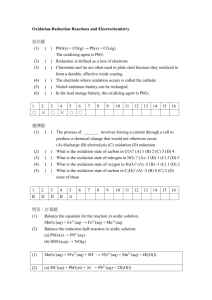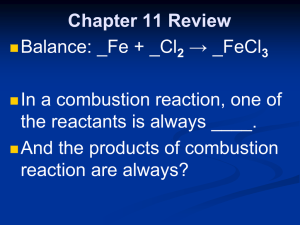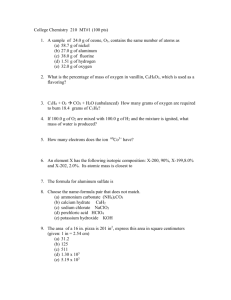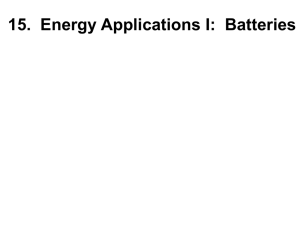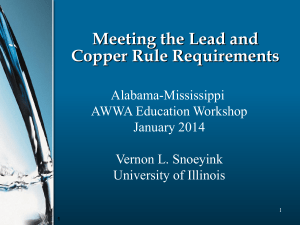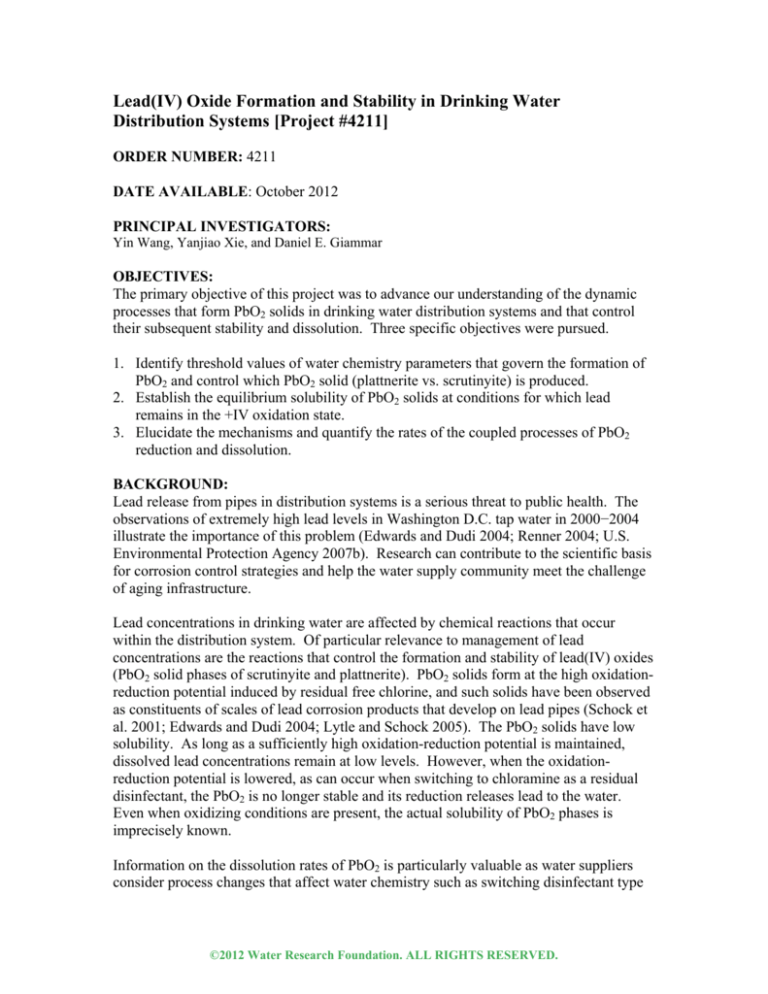
Lead(IV) Oxide Formation and Stability in Drinking Water
Distribution Systems [Project #4211]
ORDER NUMBER: 4211
DATE AVAILABLE: October 2012
PRINCIPAL INVESTIGATORS:
Yin Wang, Yanjiao Xie, and Daniel E. Giammar
OBJECTIVES:
The primary objective of this project was to advance our understanding of the dynamic
processes that form PbO2 solids in drinking water distribution systems and that control
their subsequent stability and dissolution. Three specific objectives were pursued.
1. Identify threshold values of water chemistry parameters that govern the formation of
PbO2 and control which PbO2 solid (plattnerite vs. scrutinyite) is produced.
2. Establish the equilibrium solubility of PbO2 solids at conditions for which lead
remains in the +IV oxidation state.
3. Elucidate the mechanisms and quantify the rates of the coupled processes of PbO2
reduction and dissolution.
BACKGROUND:
Lead release from pipes in distribution systems is a serious threat to public health. The
observations of extremely high lead levels in Washington D.C. tap water in 2000−2004
illustrate the importance of this problem (Edwards and Dudi 2004; Renner 2004; U.S.
Environmental Protection Agency 2007b). Research can contribute to the scientific basis
for corrosion control strategies and help the water supply community meet the challenge
of aging infrastructure.
Lead concentrations in drinking water are affected by chemical reactions that occur
within the distribution system. Of particular relevance to management of lead
concentrations are the reactions that control the formation and stability of lead(IV) oxides
(PbO2 solid phases of scrutinyite and plattnerite). PbO2 solids form at the high oxidationreduction potential induced by residual free chlorine, and such solids have been observed
as constituents of scales of lead corrosion products that develop on lead pipes (Schock et
al. 2001; Edwards and Dudi 2004; Lytle and Schock 2005). The PbO2 solids have low
solubility. As long as a sufficiently high oxidation-reduction potential is maintained,
dissolved lead concentrations remain at low levels. However, when the oxidationreduction potential is lowered, as can occur when switching to chloramine as a residual
disinfectant, the PbO2 is no longer stable and its reduction releases lead to the water.
Even when oxidizing conditions are present, the actual solubility of PbO2 phases is
imprecisely known.
Information on the dissolution rates of PbO2 is particularly valuable as water suppliers
consider process changes that affect water chemistry such as switching disinfectant type
©2012 Water Research Foundation. ALL RIGHTS RESERVED.
or dose, adjusting pH, or adding a corrosion inhibitor. Recent research linked the high
lead concentrations in the Washington D.C. service area from 2000−2004 to the
breakdown of PbO2 solids following a change in the residual disinfectant from free
chlorine to chloramine (Edwards and Dudi 2004; Renner 2004; U.S. Environmental
Protection Agency 2007b). For other utilities that are considering switching from free
chlorine to chloramine, information is needed on the rates and mechanisms of PbO2
dissolution as a function of water chemistry. Orthophosphate has been demonstrated to
decrease dissolved lead concentrations for systems using chloramine (Edwards and
McNeill 2002; U.S. Environmental Protection Agency 2007b). Strategies that inhibit
PbO2 dissolution and minimize lead release can be optimized based on an understanding
of the effects of water chemistry on lead release rates.
APPROACH:
The project was divided into three integrated tasks that corresponded to the three research
objectives (Figure ES.1). The tasks progressed from (1) the formation of PbO2, to (2) the
stability of PbO2 in equilibrated systems, and finally to (3) the rates of dissolution of
PbO2. All tasks integrated dissolved phase analysis with characterization of the
structures and compositions of the solid phases; this approach facilitated observation of
macroscopic precipitation and dissolution processes while developing a mechanistic basis
for those processes.
Figure ES.1 Integrated approach to investigate dynamics of PbO2 in distribution
Task 1: Critical Water Chemistry Thresholds for the Formation of PbO2
The impact of water chemistry on the extent of PbO2 formation and the identity of the
PbO2 phases formed was evaluated in a series of bench-scale laboratory experiments.
The formation of PbO2 by the oxidation of different lead(II) and lead(0) precursors in
water was investigated as a function of free chlorine concentration, pH, dissolved
inorganic carbon (DIC), and time. Experiments were performed with five different
precursor materials: elemental lead(0) powder, dissolved lead(II) chloride (PbCl2), the
lead(II) oxide massicot (β-PbO), the lead(II) carbonate cerussite (PbCO3), and the lead(II)
hydroxycarbonate hydrocerussite (Pb(OH)2(CO3)2). Aqueous and solid phase samples
©2012 Water Research Foundation. ALL RIGHTS RESERVED.
were collected over reaction times up to 28 days. The presence of PbO2 in the products
of the reaction was identified using scanning electron microscopy (SEM) and X-ray
diffraction (XRD). These methods were also used to identify intermediate products of
the reaction that could influence the rate of PbO2 formation and the identity of the
specific PbO2 solid that formed (scrutinyite versus plattnerite).
Task 2: Determination of Equilibrium Solubility of PbO2
The dissolved lead concentrations achieved in aqueous solutions equilibrated with the
two PbO2 polymorphs, scrutinyite and plattnerite, were measured as a function of pH at
free chlorine concentrations designed to keep lead in the +IV oxidation state. Batch
experiments were conducted with pure forms of plattnerite and scrutinyite. Filtered
samples were collected over time to determine the concentration at which dissolved lead
stabilized and the time to reach that stable state. Solids were also collected and
characterized by XRD and SEM to probe for any transformations of the solids that might
have occurred during the equilibrations.
Task 3: Coupled Reduction-Detachment Processes During Dissolution of PbO2
The dissolution rates of plattnerite were examined as a function of water chemistry
parameters that included pH, DIC, iodide, free chlorine, and orthophosphate. Because
PbO2 is often found in systems that are not at equilibrium, information about rates and
not equilibrium solubility may be more important for predicting lead concentrations in
water that has been in contact with corrosion scales that contain PbO2. Dissolution rates
were quantified using continuously-stirred tank reactors loaded with plattnerite and fed
influents of controlled composition. Four sets of experiments probed different impacts of
water chemistry on the plattnerite dissolution rate.
Baseline experiments with DIC over a range of pH to determine the rates in the
absence of any oxidants, reductants, or corrosion inhibitors.
Experiments with iodide as a chemical reductant and carbonate from DIC as a Pb(II)complexing ligand to probe the mechanisms of the reductive dissolution of PbO2 as a
process involving chemical reduction and detachment.
Experiments with free chlorine present to quantify its inhibitory effect on PbO2
dissolution and to probe for a critical concentration required to limit lead release.
Experiments with orthophosphate present as a potential corrosion inhibitor.
RESULTS/CONCLUSIONS:
The research project made significant findings regarding the formation and stability of
lead(IV) oxides at conditions relevant to drinking water distribution systems. Key
findings with respect to formation, equilibrium dissolved lead concentrations, and PbO2
dissolution rates are outlined below.
©2012 Water Research Foundation. ALL RIGHTS RESERVED.
Formation of Lead(IV) Oxides
PbO2 can only form in the presence of free chlorine, and the threshold free chlorine
concentration for producing PbO2 is less than 4 mg Cl2/L.
The formation of PbO2 is accelerated by the presence of dissolved inorganic carbon.
Both polymorphs of PbO2 (plattnerite and scrutinyite) can form, and most conditions
resulted in a mixture of the two phases. The identity of the Pb(II)-containing
precursor could control the identity of the specific PbO2 phase that formed.
Dissolved Lead Concentrations in Equilibrated Solutions
Dissolved lead concentrations from equilibration of PbO2 in water with free chlorine
were orders of magnitude higher than predicted from published thermodynamic data.
Low dissolved lead concentrations in chlorinated solutions were still maintained over
long periods of time. It was only after long stagnation times of 4 days or longer that
the action level was reached at pH 7.5 and 8.5, and the action level was never reached
at pH 6.0.
The final dissolved lead concentrations achieved upon long-term contact of plattnerite
and scrutinyite with water were similar.
Dissolved lead concentrations increased with increasing pH above pH 6 and were
unaffected by the presence of DIC.
Dissolution Rates of PbO2
The dissolution rate and not the equilibrium solubility of PbO2 will control dissolved
lead concentrations in waters that are in contact with PbO2 as a corrosion product for
most relevant stagnation times.
The rate of PbO2 dissolution rate decreased with increasing pH. This is in contrast to
the dissolved lead concentrations after multi-day equilibration that increased with
increasing pH.
Dissolution was strongly inhibited by free chlorine even at concentrations as low as
0.2 mg Cl2/L.
Orthophosphate inhibited PbO2 dissolution with its effects limited to near-neutral pH.
The presence of chemical reductants can significantly accelerate the dissolution of
PbO2. Dissolution of PbO2 is a two-step process that involves chemical reduction of
Pb(IV) to Pb(II) followed by detachment of Pb(II) and release to solution. For most
conditions the chemical reduction steps will be rate-limiting.
APPLICATIONS/RECOMMENDATIONS:
Lead(IV) oxides (PbO2) can be an important component of corrosion products on pipe
scales for utilities that have lead service lines in their distribution systems and that
currently use or have used free chlorine as the secondary disinfectant. PbO2 can only
form in systems with free chlorine present; however, because of the low solubility of this
phase and the complexity of pipe scales, PbO2 may persist well after a switch from free
chlorine to chloramine. The rate of PbO2 formation and consequently the likely extent of
PbO2 formation on lead service lines is strongly affected by the water chemistry of the
©2012 Water Research Foundation. ALL RIGHTS RESERVED.
distribution system. The susceptibility of PbO2 to reductive dissolution and its likely
enrichment at the surface of the pipe scale can make it a major contributor to lead release
to water even when it is only present as a minor constituent of a pipe scale. The presence
of PbO2 is a more important finding then the exact identity of the form of PbO2
(plattnerite versus scrutinyite) that is present. Both plattnerite and scrutinyite can form
on lead pipes in the presence of free chlorine, but similar dissolved lead concentrations
were achieved in aqueous solutions equilibrated with the two solids. When free chlorine
is present, low dissolved lead concentrations below the action level can be achieved even
for stagnation times of several days.
For PbO2-containing systems without free chlorine or for which free chlorine has been
depleted, dissolved lead concentrations will be controlled by the rate of the dissolution
reaction and not by equilibrium solubility. The dissolution rate of PbO2 is a very strong
function of the water chemistry, and orders of magnitude differences can occur in the
rates depending on the composition. Utilities should be aware of conditions that could
accelerate the dissolution of PbO2 and the release of lead from this potential reservoir of
unstable lead in scales on lead service lines. This is particularly important for systems
that have recently switched from using free chlorine to chloramine as the secondary
disinfectant. Dissolution rates of PbO2 will increase in response to process changes that
lower the pH of the water in the distribution system. The most significant parameter
affecting PbO2 dissolution rates is the concentration and identity of species that can act as
chemical reductants to accelerate PbO2 dissolution. These species include natural organic
matter, dissolved iron(II) and manganese(II), and iodide. The impacts of water chemistry
on the dissolution rate of PbO2 can also be used to promote conditions with the slowest
dissolution rates and consequently the best abilities to maintain low lead concentrations
in distribution systems. Free chlorine is an excellent inhibitor of the reductive dissolution
of PbO2 even at concentrations as low as 0.2 mg/L as Cl2. Orthophosphate can also be
effective at limiting the release of lead to water in systems that contain PbO2 for systems
with pH values near neutral.
©2012 Water Research Foundation. ALL RIGHTS RESERVED.

